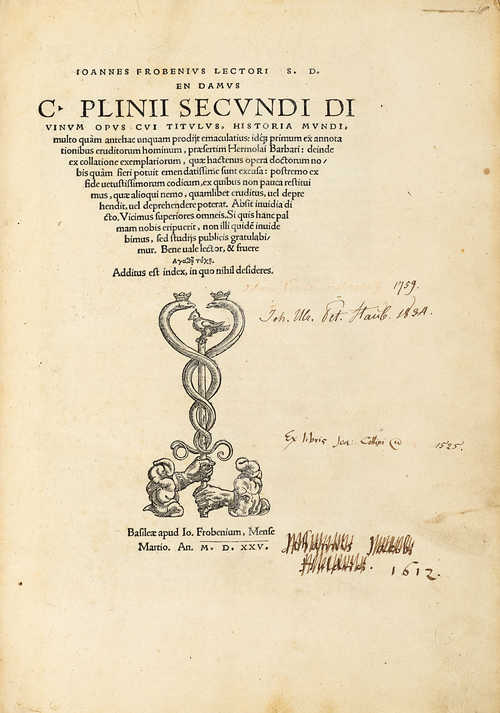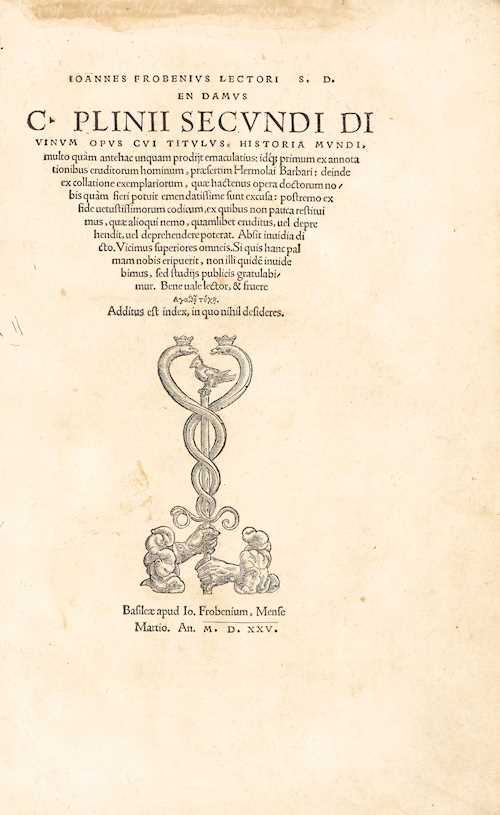PLINIUS SECUNDUS, Gaius (23-79). Historia naturalis , in Italian. Translated from Latin by Cristoforo Landino (1424-1492). Venice: Nicolaus Jenson, 1476. 2 volumes, super-royal 2 o (411 x 274 mm). Collation: [1-21 1 0 22-26 8 27-35 1 0 36 1 0(36/10+1) 37 8 38 1 0 39 8 40-41 1 0 42 8 43 1 0 (1/1 blank, 1/2r translator's dedication to Ferrante, King of Naples, 1/5v blank, 1/6r Pliny's dedication, 1/7v table of contents, 3/1v blank, 3/2r text, 43/9v colophon, 43/10 blank)]. 413 leaves (of 415, without the first and last blanks). 50 lines. Types: 1:115(111)R; 115Gk (occasional words). Spaces for initials with guide letters. Illuminated by a contemporary Italian artist: opening text page (3/2r) decorated with three-quarter border of swirling foliage and blossoms with gold bezants and penwork flourishes, at bottom the wreath-enclosed coat-of-arms of a member of the Zancaruolo family (extenders of lower border shaved, half of escutcheon oxidized); 11-line historiated initial showing the white-bearded author holding a book and an astrolabe; 13-line preface initial, 6-line prohemio initial, and 35 10- or 11-line book initials (the initial to book 33 omitted), all antiqua initials in gold leaf on pink, green and blue grounds with delicate white or yellow filigree infill (small rubbed area to first initial). 2-line antiqua chapter initials in alternating red and blue (many of the blue initials faded from washing, about 20 sheets more heavily washed leaving mere faint traces of the initials). Two pinholes preserved in outer corners of many leaves. The volumes divided between 23/7 and 23/8 (books 18 and 19). (Neatly repaired tear to first leaf of text [3/2] crossing illuminated border, last leaf [43/9] damaged and repaired affecting a few words on verso, small marginal repair to first leaf, tiny tear to fol. 3/2, repaired marginal tear to 10/5, filled wormhole in 8/7-8 affecting 2 letters in 8/8 neatly touched up in ink, some light mostly marginal foxing.) Binding : 19th-century French dark blue straight-grained morocco gold tooled to a sober neo-classical design, sides panelled with triple gold fillets enclosing diaper and palmette rolls in blind, an inner panel of a single gold fillet framing gilt cornerpiece tools in gold and a different blind palmette roll, spines divided into six blind-and gold-tooled compartments, the second and sixth compartments lettered in gold, board edges gilt, turn-ins decorated with blind roll and gilt fillets, edges gilt, marbled endpapers, paper outer flyleaves, vellum inner flyleaves, by RENé SIMIER, with his gilt stamp "Simier R[elieur]. du Roi" in lower compartment of spine of Vol. I (a few nicks and scratches to covers, trifling wear at corners and extremities of spines, inner hinges cracked). Provenance : Zancaruolo family of Venice (illuminated arms) -- Edward Herbert, Second Earl of Powis (1785-1848) (signature noting year of purchase 1841 on versos of front free endpapers of both volumes). FIRST EDITION IN ITALIAN AND FIRST VERNACULAR EDITION. Pliny the Elder's only extant work, the Historia naturalis was the first important scientific text to appear in print (Venice: de Spira, 1469). "A strange combination of insight, erudition, and folktales" (Stillwell Science , 684), Pliny's vast encyclopaedia set forth by his own count 20,000 facts compiled from over 100 sources (the index in fact lists 34,707 "observations" from 473 different authors). Described by Pliny the Younger as "a diffuse and learned work, no less rich in variety than nature itself" (III.5.6), it remained authoritative well into the modern period. Certain sections, notably those on materia medica and the arts and crafts, contain the best or earliest surviving accounts of the practices of Antiquity. All of the 18 recorded incunable editions were printed in Italy. The most influential book to issue from Jenson's press, Landino's translation of Pliny is also the most thoroughly documented. Documents preserved in the Archivio di Stat
PLINIUS SECUNDUS, Gaius (23-79). Historia naturalis , in Italian. Translated from Latin by Cristoforo Landino (1424-1492). Venice: Nicolaus Jenson, 1476. 2 volumes, super-royal 2 o (411 x 274 mm). Collation: [1-21 1 0 22-26 8 27-35 1 0 36 1 0(36/10+1) 37 8 38 1 0 39 8 40-41 1 0 42 8 43 1 0 (1/1 blank, 1/2r translator's dedication to Ferrante, King of Naples, 1/5v blank, 1/6r Pliny's dedication, 1/7v table of contents, 3/1v blank, 3/2r text, 43/9v colophon, 43/10 blank)]. 413 leaves (of 415, without the first and last blanks). 50 lines. Types: 1:115(111)R; 115Gk (occasional words). Spaces for initials with guide letters. Illuminated by a contemporary Italian artist: opening text page (3/2r) decorated with three-quarter border of swirling foliage and blossoms with gold bezants and penwork flourishes, at bottom the wreath-enclosed coat-of-arms of a member of the Zancaruolo family (extenders of lower border shaved, half of escutcheon oxidized); 11-line historiated initial showing the white-bearded author holding a book and an astrolabe; 13-line preface initial, 6-line prohemio initial, and 35 10- or 11-line book initials (the initial to book 33 omitted), all antiqua initials in gold leaf on pink, green and blue grounds with delicate white or yellow filigree infill (small rubbed area to first initial). 2-line antiqua chapter initials in alternating red and blue (many of the blue initials faded from washing, about 20 sheets more heavily washed leaving mere faint traces of the initials). Two pinholes preserved in outer corners of many leaves. The volumes divided between 23/7 and 23/8 (books 18 and 19). (Neatly repaired tear to first leaf of text [3/2] crossing illuminated border, last leaf [43/9] damaged and repaired affecting a few words on verso, small marginal repair to first leaf, tiny tear to fol. 3/2, repaired marginal tear to 10/5, filled wormhole in 8/7-8 affecting 2 letters in 8/8 neatly touched up in ink, some light mostly marginal foxing.) Binding : 19th-century French dark blue straight-grained morocco gold tooled to a sober neo-classical design, sides panelled with triple gold fillets enclosing diaper and palmette rolls in blind, an inner panel of a single gold fillet framing gilt cornerpiece tools in gold and a different blind palmette roll, spines divided into six blind-and gold-tooled compartments, the second and sixth compartments lettered in gold, board edges gilt, turn-ins decorated with blind roll and gilt fillets, edges gilt, marbled endpapers, paper outer flyleaves, vellum inner flyleaves, by RENé SIMIER, with his gilt stamp "Simier R[elieur]. du Roi" in lower compartment of spine of Vol. I (a few nicks and scratches to covers, trifling wear at corners and extremities of spines, inner hinges cracked). Provenance : Zancaruolo family of Venice (illuminated arms) -- Edward Herbert, Second Earl of Powis (1785-1848) (signature noting year of purchase 1841 on versos of front free endpapers of both volumes). FIRST EDITION IN ITALIAN AND FIRST VERNACULAR EDITION. Pliny the Elder's only extant work, the Historia naturalis was the first important scientific text to appear in print (Venice: de Spira, 1469). "A strange combination of insight, erudition, and folktales" (Stillwell Science , 684), Pliny's vast encyclopaedia set forth by his own count 20,000 facts compiled from over 100 sources (the index in fact lists 34,707 "observations" from 473 different authors). Described by Pliny the Younger as "a diffuse and learned work, no less rich in variety than nature itself" (III.5.6), it remained authoritative well into the modern period. Certain sections, notably those on materia medica and the arts and crafts, contain the best or earliest surviving accounts of the practices of Antiquity. All of the 18 recorded incunable editions were printed in Italy. The most influential book to issue from Jenson's press, Landino's translation of Pliny is also the most thoroughly documented. Documents preserved in the Archivio di Stat













Testen Sie LotSearch und seine Premium-Features 7 Tage - ohne Kosten!
Lassen Sie sich automatisch über neue Objekte in kommenden Auktionen benachrichtigen.
Suchauftrag anlegen